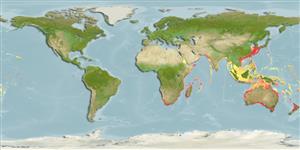Environment: milieu / climate zone / depth range / distribution range
นิเวศวิทยา
เกี่ยวกับทะเล,น้ำเค็ม; กร่อย สัตว์น้ำหน้าดิน; ระดับความลึก 1 - 200 m (Ref. 4316), usually 75 - 150 m (Ref. 33616). Subtropical; 34°N - 43°S, 15°E - 154°W
Indo-West Pacific: Delagoa Bay, Mozambique to the Cape, South Africa; common in Australia and New Zealand and reported from Japan and Korea. Also reported from Hong Kong (Ref. 12086).
Length at first maturity / ขนาด / น้ำหนัก / Age
Maturity: Lm 21.2 range ? - ? cm
Max length : 60.0 cm TL เพศผู้/กระเทย; (Ref. 4316); common length : 40.0 cm TL เพศผู้/กระเทย; (Ref. 9258); น้ำหนักสูงสุดที่มีการรายงาน: 1.5 kg (Ref. 9988); อายุสูงสุดที่ได้รายงาน: 15 ปี (Ref. 9072)
Short description
เครื่องมือที่ใช้ในการแยกชนิดสัตว์,สิ่งมีชีวิตออกจากกัน | สัณฐานวิทยา | ความยาวต่างๆ
เงี่ยงครีบหลัง (รวม) : 9 - 10; ก้านครีบอ่อนที่หาง (รวม) : 15 - 16; เงี่ยงครีบก้น: 0; ก้านครีบอ่อนที่ก้น: 14 - 16; สัตว์มีกระดูกสันหลัง: 33 - 35. Olive or brownish in color, becomes red when stressed; lower half of the inner part of pectoral fin with large black blotch surrounded by numerous pale spots (Ref. 9771).
Found from estuaries to edge of continental shelves over sand and sandy shell seabed (Ref. 9258). Reported to be often found in rivers (Ref. 4316). Juveniles may occur in bays (Ref. 33616). Benthic (Ref. 58302). Dorsal spine reported to be venomous (Ref. 9771). Neither anterolateral glandular grooves nor venom gland is present (Ref. 57406). Current information in the table (dangerous fish) do not match; needs verification. Excellent food fish (Ref. 9771). Utilized fresh and frozen; eaten pan-fried, broiled, microwaved and baked (Ref. 9988).
Heemstra, P.C., 1986. Triglidae. p. 486-488. In M.M. Smith and P.C. Heemstra (eds.) Smiths' sea fishes. Springer-Verlag, Berlin. (Ref. 4316)
IUCN Red List Status (Ref. 130435: Version 2024-1)
Human uses
การประมง: การค้า
เครื่องมือ
Special reports
Download XML
แหล่งที่มาจากอินเตอร์เน็ต
Estimates based on models
Preferred temperature (Ref.
123201): 13.3 - 25, mean 19.3 °C (based on 186 cells).
Phylogenetic diversity index (Ref.
82804): PD
50 = 0.5010 [Uniqueness, from 0.5 = low to 2.0 = high].
Bayesian length-weight: a=0.00776 (0.00407 - 0.01480), b=3.07 (2.90 - 3.24), in cm total length, based on LWR estimates for this species & (Sub)family-body (Ref.
93245).
ระดับชั้นอาหาร (Ref.
69278): 3.7 ±0.57 se; based on food items.
Generation time: 2.7 (1.9 - 3.0) years. Estimated as median ln(3)/K based on 10
growth studies.
ความสามารถในการกลับคืนสู่ปกติ (Ref.
120179): ขนาดกลาง, เวลาต่ำสุดที่จะทำให้ประชากรเพิ่มขึ้นเป็น 2 เท่าใช้เวลา 1.4 - 4.4 ปี (K=0.4-0.6; tm=2-3; tmax=15;).
Prior r = 0.36, 95% CL = 0.24 - 0.55, Based on 1 data-limited stock assessment.
Fishing Vulnerability (Ref.
59153): Low to moderate vulnerability (29 of 100).
Climate Vulnerability (Ref.
125649): Moderate to high vulnerability (45 of 100).
Nutrients (Ref.
124155): Calcium = 88.2 [46.4, 215.9] mg/100g; Iron = 1.09 [0.59, 2.04] mg/100g; Protein = 19.3 [18.0, 20.7] %; Omega3 = 0.381 [0.173, 1.076] g/100g; Selenium = 41.3 [20.5, 90.6] μg/100g; VitaminA = 7.38 [2.92, 18.85] μg/100g; Zinc = 0.753 [0.531, 1.080] mg/100g (wet weight); based on
nutrient studies.
